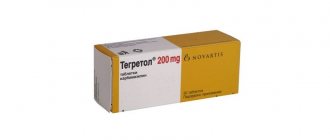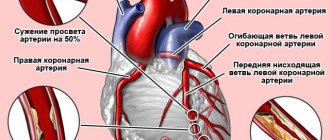Indications for use of Finlepsin
According to the instructions for Finlepsin, the indications for its use are:
- epilepsy (including absence seizures, flaccid, myoclonic seizures);
- idiopathic trigeminal neuralgia;
- typical and atypical trigeminal neuralgia caused by multiple sclerosis;
- idiopathic neuralgia of the glossopharyngeal nerve;
- acute manic states (in the form of monotherapy or combination treatment);
- phasic affective disorders;
- alcohol withdrawal syndrome;
- diabetes insipidus of central origin;
- polydipsia and polyuria of neurohormonal origin.
Contraindications to the use of Finlepsin
The instructions for Finlepsin describe the following contraindications for its use:
- hypersensitivity to carbamazepine;
- violation of bone marrow hematopoiesis;
- acute intermittent porphyria;
- simultaneous use of MAO inhibitors;
- AV block.
Finlepsin should be used with caution in decompensated CHF, ADH hypersecretion syndrome, hypopituitarism, adrenal insufficiency, hypothyroidism, active alcoholism, old age, liver failure, increased intraocular pressure.
Side effects of Finlepsin
The following side effects have been reported when using Finlepsin:
- from the nervous system: dizziness, headache, disturbance of thinking, consciousness, hallucinations, paresthesia, hyperkinesis, unmotivated aggression;
- from the gastrointestinal tract: vomiting, nausea, increased liver transaminases;
- from the cardiovascular system: increase or decrease in blood pressure, decrease in heart rate, impaired AV conduction;
- from the hematopoietic system: decrease in the number of neutrophils, leukocytes, platelets;
- from the kidneys: oliguria, hematuria, nephritis, edema, renal failure;
- from the respiratory system: pulmonitis;
- from the endocrine system: increased prolactin levels, accompanied by galactorrhea, gynecomastia, changes in the level of thyroid hormones;
- others: allergic reactions, including Stevens-Johnson syndrome.
A large number of side effects cause negative reviews of Finlepsin from patients. Their appearance can be prevented or their severity can be reduced by using Finlepsin according to the instructions in an adequate dosage and under strict medical supervision.
Finlepsin® (Finlepsin®)
Monotherapy for epilepsy begins with a low initial dose, gradually increasing it until the desired therapeutic effect is achieved.
When selecting the optimal dose, it is advisable to determine the concentration of carbamazepine in the blood plasma, especially during combination therapy. In some cases, the optimal dose may deviate significantly from the recommended initial and maintenance dose, for example, due to the induction of microsomal liver enzymes or due to interactions during combination therapy.
Finlepsin® should not be combined with sedative-hypnotics. If necessary, it can be combined with other substances used to treat alcohol withdrawal. During treatment, it is necessary to regularly monitor the content of carbamazepine in the blood plasma. Due to the development of side effects from the central and autonomic nervous system, patients are closely monitored in a hospital setting. When transferring a patient to carbamazepine, the dose of the previously prescribed antiepileptic drug should be gradually reduced until it is completely discontinued. Sudden cessation of carbamazepine may trigger epileptic seizures. If it is necessary to abruptly interrupt treatment, the patient should be transferred to another antiepileptic drug under the cover of the drug indicated in such cases (for example, diazepam administered intravenously or rectally, or phenytoin administered intravenously).
Several cases of vomiting, diarrhea and/or decreased nutrition, convulsions and/or respiratory depression have been described in newborns whose mothers took carbamazepine concomitantly with other anticonvulsants (these reactions may represent neonatal withdrawal syndrome). Before prescribing carbamazepine and during treatment, liver function testing is necessary, especially in patients with a history of liver disease, as well as in elderly patients. If existing liver dysfunction worsens or active liver disease develops, the drug should be discontinued immediately. Before starting treatment, it is necessary to conduct a study of the blood picture (including counting platelets, reticulocytes), iron level in the blood serum, general urine analysis, urea level in the blood, electroencephalogram, determination of the concentration of electrolytes in the blood serum (and periodically during treatment, because hyponatremia may develop). Subsequently, these indicators should be monitored weekly during the first month of treatment and then monthly.
In most cases, a transient or persistent decrease in the number of platelets and/or leukocytes is not a precursor to the onset of aplastic anemia or agranulocytosis. However, before starting treatment, and periodically during treatment, clinical blood tests should be performed, including platelet counts and possibly reticulocyte counts, and serum iron levels should be determined. Non-progressive asymptomatic leukopenia does not require discontinuation, however, treatment should be discontinued if progressive leukopenia or leukopenia accompanied by clinical symptoms of an infectious disease occurs. Carbamazepine should be discontinued immediately if hypersensitivity reactions or symptoms suggestive of Stevens-Johnson syndrome or Lyell's syndrome occur. Mild skin reactions (isolated macular or maculopapular exanthema) usually disappear within a few days or weeks, even with continued treatment or after reducing the dose of the drug (the patient should be under close medical supervision at this time).
The possibility of activation of latent psychoses should be taken into account, and in elderly patients, the possibility of developing disorientation or psychomotor agitation.
In some cases, treatment with antiepileptic drugs was accompanied by the occurrence of suicide attempts/suicidal intentions. This was also confirmed in a meta-analysis of randomized clinical trials using antiepileptic drugs. Since the mechanism of suicide attempts when using antiepileptic drugs is not known, their occurrence cannot be ruled out when treating patients with Finlepsin®. Patients and staff should be warned to monitor for suicidal thoughts/behavior and to seek immediate medical attention if symptoms occur.
Male fertility and/or spermatogenesis disorders are possible, but the relationship between these disorders and carbamazepine has not yet been established.
Intermenstrual bleeding may occur with simultaneous use of oral contraceptives. Carbamazepine may adversely affect the reliability of oral contraceptives, so women of reproductive age should use alternative methods of birth control during treatment.
Carbamazepine should only be used under medical supervision. Patients should be informed of early signs of toxicity, as well as skin and liver symptoms. The patient is informed of the need to immediately consult a doctor in case of adverse reactions such as fever, sore throat, rash, ulceration of the oral mucosa, causeless bruising, hemorrhages in the form of petechiae or purpura.
Before starting treatment, it is recommended to conduct an ophthalmological examination, including fundus examination and measurement of intraocular pressure. If the drug is prescribed to patients with increased intraocular pressure, constant monitoring of this indicator is required.
Patients with severe cardiovascular diseases, liver and kidney damage, as well as elderly people are prescribed lower doses of the drug. Although the relationship between the dose of carbamazepine, its concentration and clinical efficacy or tolerability is very small, regular determination of carbamazepine levels may be useful in the following situations: with a sharp increase in the frequency of attacks; to check whether the patient is taking the drug properly; during pregnancy; when treating children or adolescents; if there is a suspicion of impaired absorption of the drug; if toxic reactions are suspected if the patient is taking several medications.
During treatment with Finlepsin® it is recommended to refrain from drinking alcohol.
Interaction of Finlepsin with other drugs
The simultaneous use of Finlepsin with MAO inhibitors is unacceptable. Other anticonvulsants can reduce the anticonvulsant effect of Finlepsin. When taking this drug simultaneously with valproic acid, disorders of consciousness and coma may develop. Finlepsin increases the toxicity of lithium preparations. With the simultaneous use of macrolides, calcium channel blockers, isoniazid, cimetidine with Finlepsin, the plasma concentration of the latter increases. Finlepsin reduces the activity of anticoagulants and contraceptives.
Overdose
An overdose of Finlepsin may result in impaired consciousness, depression of the respiratory and cardiovascular systems, impaired hematopoiesis, and kidney damage. Nonspecific therapy: gastric lavage, use of laxatives and enterosorbents. Due to the high ability of the drug to bind to plasma proteins, peritoneal dialysis and forced diuresis are not effective in case of an overdose of Finlepsin. Hemosorption is carried out on coal sorbents. In young children, exchange transfusions may be performed.
Finlepsin 200 retard
When assessing the frequency of occurrence of various adverse reactions, the following gradations were used: very often - 10% and more often; often - 1-10%; sometimes - 0.1-1%; rarely - 0.01-0.1%; very rare - less than 0.01%.
Dose-dependent adverse reactions usually resolve within a few days, either spontaneously or after a temporary dose reduction. The development of adverse reactions from the central nervous system may be a consequence of a relative overdose of the drug or significant fluctuations in the concentrations of the active substance in plasma. In such cases, it is recommended to monitor the concentration of drugs in plasma.
From the side of the central nervous system: very often - dizziness, ataxia, drowsiness, asthenia; often - headache, accommodation paresis; sometimes - abnormal involuntary movements (for example, tremor, “fluttering” tremor - asterixis, dystonia, tics); nystagmus; rarely - orofacial dyskinesia, oculomotor disorders, speech disorders (eg dysarthria), choreoathetoid disorders, peripheral neuritis, paresthesia, myasthenia gravis and symptoms of paresis. The role of Finlepsin as a drug that causes or contributes to the development of neuroleptic malignant syndrome, especially when it is prescribed in conjunction with antipsychotics, remains unclear.
From the mental sphere: rarely - hallucinations (visual or auditory), depression, loss of appetite, anxiety, aggressive behavior, agitation, disorientation; very rarely - activation of psychosis.
Allergic reactions: often - urticaria; sometimes - erythroderma; rarely - lupus-like syndrome, skin itching; very rarely - exudative erythema multiforme (including Stevens-Johnson syndrome), toxic epidermal necrolysis (Lyell's syndrome), photosensitivity.
Rarely - multiorgan delayed-type hypersensitivity reactions with fever, skin rash, vasculitis (including erythema nodosum as a manifestation of cutaneous vasculitis), lymphadenopathy, signs resembling lymphoma, arthralgia, leukopenia, eosinophilia, hepatosplenomegaly and altered liver function tests (these manifestations found in various combinations). Other organs (eg, lungs, kidneys, pancreas, myocardium, colon) may also be involved. Very rarely - aseptic meningitis with myoclonus and peripheral eosinophilia, anaphylactoid reaction, angioedema, allergic pneumonitis or eosinophilic pneumonia. If the above allergic reactions occur, use of the drug should be discontinued.
From the hematopoietic organs: very often - leukopenia; often - thrombocytopenia, eosinophilia; rarely - leukocytosis, lymphadenopathy, folic acid deficiency; very rarely - agranulocytosis, aplastic anemia, true erythrocyte aplasia, megaloblastic anemia, acute intermittent porphyria, reticulocytosis, hemolytic anemia.
From the digestive system: very often - nausea, vomiting; often - dry mouth; sometimes - diarrhea or constipation, abdominal pain; very rarely - glossitis, stomatitis, pancreatitis.
From the liver: very often - increased GGT activity (due to the induction of this enzyme in the liver), which usually does not matter; often - increased alkaline phosphatase activity; sometimes - increased activity of “liver” transaminases; rarely - hepatitis of cholestatic, parenchymal (hepatocellular) or mixed type, jaundice; very rarely - granulomatous hepatitis, liver failure.
From the cardiovascular system: rarely - intracardiac conduction disorders; decrease or increase in blood pressure; very rarely - bradycardia, arrhythmias, AV block with fainting, collapse, worsening or development of CHF, exacerbation of coronary heart disease (including the appearance or increase in angina attacks), thrombophlebitis, thromboembolic syndrome.
From the endocrine system and metabolism: often - edema, fluid retention, weight gain, hyponatremia (decrease in plasma osmolarity due to an effect similar to the effect of ADH, which in rare cases leads to dilution hyponatremia, accompanied by lethargy, vomiting, headache, disorientation and neurological disorders); very rarely - hyperprolactinemia (may be accompanied by galactorrhea and gynecomastia); a decrease in the concentration of L-thyroxine (free T4, T4, T3) and an increase in the concentration of TSH (usually not accompanied by clinical manifestations); disorders of calcium-phosphorus metabolism in bone tissue (decreased concentrations of Ca2+ and 25-OH-colecalciferol in plasma): osteomalacia; hypercholesterolemia (including HDL cholesterol) and hypertriglyceridemia.
From the genitourinary system: very rarely - interstitial nephritis, renal failure, impaired renal function (for example, albuminuria, hematuria, oliguria, increased urea/azotemia), frequent urination, urinary retention, decreased potency.
From the musculoskeletal system: very rarely - arthralgia, myalgia or convulsions.
From the senses: very rarely - disturbances in taste, clouding of the lens, conjunctivitis; hearing impairment, incl. tinnitus, hyperacusis, hypoacusia, changes in the perception of pitch.
Other: skin pigmentation disorders, purpura, acne, increased sweating, alopecia. Rare cases of hirsutism have been reported, but the causal relationship of this complication to carbamazepine remains unclear.
Overdose. Symptoms: usually reflect disorders of the central nervous system, cardiovascular system and respiratory system.
From the side of the central nervous system and sensory organs - depression of central nervous system functions, disorientation, drowsiness, agitation, hallucinations, fainting, coma; visual disturbances (“fog” before the eyes), dysarthria, nystagmus, ataxia, dyskinesia, hyperreflexia (initially), hyporeflexia (later); convulsions, psychomotor disorders, myoclonus, hypothermia, mydriasis).
From the cardiovascular system: tachycardia, decreased blood pressure, sometimes increased blood pressure, intraventricular conduction disturbances with widening of the QRS complex; heart failure.
From the respiratory system: respiratory depression, pulmonary edema.
From the digestive system: nausea and vomiting, delayed evacuation of food from the stomach, decreased motility of the colon.
From the urinary system: urinary retention, oliguria or anuria; fluid retention; dilution hyponatremia.
Laboratory indicators: leukocytosis or leukopenia, hyponatremia, metabolic acidosis, hyperglycemia and glycosuria, increased CPK muscle fraction.
Treatment: there is no specific antidote. Treatment is based on the patient's clinical condition; hospitalization, determination of the concentration of carbamazepine in plasma (to confirm poisoning with this drug and assess the degree of overdose), gastric lavage, administration of activated charcoal are indicated (late evacuation of gastric contents can lead to delayed absorption for 2 and 3 days and the reappearance of symptoms of intoxication during the recovery period) .
Forced diuresis, hemodialysis and peritoneal dialysis are ineffective (dialysis is indicated for a combination of severe poisoning and renal failure). Young children may require exchange transfusions. Symptomatic supportive treatment in the intensive care unit, monitoring of cardiac function, body temperature, corneal reflexes, renal and bladder function, correction of electrolyte disorders. When blood pressure decreases: position with the head end down, plasma expanders, if ineffective - intravenous dopamine or dobutamine; for heart rhythm disturbances, treatment is selected individually; for convulsions - administration of benzodiazepines (for example diazepam), with caution (due to a possible increase in respiratory depression) administration of other anticonvulsants (for example phenobarbital). With the development of dilution hyponatremia (water intoxication), limit the administration of fluids and slow intravenous infusion of a 0.9% NaCl solution (can help prevent the development of cerebral edema). It is recommended to carry out hemosorption on carbon sorbents.
special instructions
Before using this drug, you must study the instructions for Finlepsin in detail.
When selecting the optimal dosage, it is advisable to determine the plasma concentration of carbamazepine. Sudden withdrawal of the drug can provoke an epileptic seizure. Monitoring of liver tramsaminases is also necessary when prescribing Finlepsin. According to strict indications, Finlepsin can be used by patients with increased intraocular pressure, but this indicator must be monitored.
Finlepsin
Use during pregnancy and breastfeeding
For women of reproductive age, Finlepsin® is prescribed, if possible, as monotherapy, in the minimum effective dose, because
the incidence of congenital anomalies in newborns from mothers taking combined antiepileptic treatment is higher than with monotherapy. When pregnancy occurs, it is necessary to compare the expected benefits of therapy and possible complications, especially in the first trimester of pregnancy. It is known that children of mothers with epilepsy are predisposed to disorders of intrauterine development, including malformations. Finlepsin® may increase the risk of these disorders. There are isolated reports of cases of congenital diseases and malformations, including spina bifida. Antiepileptic drugs increase folic acid deficiency, which is often observed during pregnancy, which may increase the incidence of birth defects in children, so folic acid supplementation is recommended before and during pregnancy.
In order to prevent hemorrhagic complications in newborns, it is recommended that women in the last weeks of pregnancy, as well as newborns, be prescribed vitamin K.
Carbamazepine passes into breast milk, so the benefits and possible undesirable effects of breastfeeding should be weighed against ongoing therapy. If breastfeeding is continued while taking Finlepsin, the child should be monitored due to the possibility of adverse reactions (for example, severe drowsiness, allergic skin reactions).
Use for liver dysfunction
The drug should be used with caution in cases of liver dysfunction.
Use for renal impairment
The drug should be used with caution in cases of impaired renal function.
Use in children
Can be used in children according to indications.
special instructions
Monotherapy for epilepsy begins with a low initial dose, gradually increasing it until the desired therapeutic effect is achieved.
When selecting the optimal dose, it is advisable to determine the concentration of carbamazepine in the blood plasma, especially during combination therapy. In some cases, the optimal dose may deviate significantly from the recommended initial maintenance dose, for example, due to induction of microsomal liver enzymes or due to interactions during combination therapy.
In some cases, treatment with antiepileptic drugs was accompanied by the occurrence of suicide attempts/suicidal intentions. This was also confirmed in a meta-analysis of randomized clinical trials using antiepileptic drugs. Since the mechanism of suicide attempts when using antiepileptic drugs is not known, their occurrence cannot be excluded during treatment with Finlepsin®. Patients and staff should be warned to monitor for suicidal thoughts/behavior and to seek immediate medical attention if symptoms occur.
Finlepsin® should not be combined with sedative-hypnotics. If necessary, it can be combined with other substances used to treat alcohol withdrawal. During treatment, it is necessary to regularly monitor the content of carbamazepine in the blood plasma. Due to the development of side effects from the central nervous system and the autonomic nervous system, patients are closely monitored in a hospital setting.
When transferring a patient to carbamazepine, the dose of the previously prescribed antiepileptic drug should be gradually reduced until it is completely discontinued. Sudden cessation of carbamazepine may trigger epileptic seizures. If it is necessary to abruptly interrupt treatment, the patient should be transferred to another antiepileptic drug under the cover of the drug indicated in such cases (for example, diazepam administered intravenously or rectally, or phenytoin administered intravenously).
Several cases of vomiting, diarrhea and/or decreased nutrition, convulsions and/or respiratory depression have been described in newborns whose mothers took carbamazepine concomitantly with other anticonvulsants (these reactions may represent neonatal withdrawal syndrome).
Before prescribing carbamazepine and during treatment, liver function testing is necessary, especially in patients with a history of liver disease, as well as in elderly patients. If existing liver dysfunction worsens or active liver disease develops, the drug should be discontinued immediately.
Before starting treatment, it is necessary to conduct a study of the blood picture (including counting platelets, reticulocytes), iron level in the blood serum, general urine analysis, urea level in the blood, electroencephalogram, determination of the concentration of electrolytes in the blood serum (and periodically during treatment, because hyponatremia may develop). Subsequently, these indicators should be monitored weekly during the first month of treatment and then monthly.
In most cases, a transient or persistent decrease in the number of platelets and/or leukocytes is not a precursor to the onset of aplastic anemia or agranulocytosis. However, before starting treatment, and periodically during treatment, clinical blood tests should be performed, including platelet counts and possibly reticulocyte counts, and serum iron levels should be determined. Non-progressive asymptomatic leukopenia does not require discontinuation, but treatment should be discontinued if hypersensitivity reactions or symptoms appear that suggest the development of Stevens-Johnson syndrome or Lyell's syndrome. Mild skin reactions (isolated macular or maculopapular exanthema) usually disappear within a few days or weeks, even with continued treatment or after reducing the dose of the drug (the patient should be under close medical supervision at this time).
The possibility of activation of latent psychoses should be taken into account, and in elderly patients, the possibility of developing disorientation or psychomotor agitation.
Male fertility and/or spermatogenesis disorders are possible, but the relationship between these disorders and carbamazepine has not yet been established.
Intermenstrual bleeding may occur with simultaneous use of oral contraceptives. Carbamazepine may adversely affect the reliability of oral contraceptives, so women of reproductive age should use alternative methods of birth control during treatment. Carbamazepine should only be used under medical supervision.
Patients should be informed of early signs of toxicity, as well as skin and liver symptoms. The patient is informed of the need to immediately consult a doctor in case of adverse reactions such as fever, sore throat, rash, ulceration of the oral mucosa, causeless bruising, hemorrhages in the form of petechiae or purpura.
Before starting treatment, it is recommended to conduct an ophthalmological examination, including slit lamp examination of the fundus and measurement of intraocular pressure. If the drug is prescribed to patients with increased intraocular pressure, constant monitoring of this indicator is required.
Patients with severe cardiovascular diseases, liver and kidney damage, as well as elderly people are prescribed lower doses of the drug.
Although the relationship between the dose of carbamazepine, its concentration and clinical efficacy or tolerability is very small, regular determination of carbamazepine levels may be useful in the following situations: with a sharp increase in the frequency of attacks; to check whether the patient is taking the drug properly; during pregnancy; when treating children or adolescents; if there is a suspicion of impaired absorption of the drug; if toxic reactions are suspected if the patient is taking several medications.
During treatment with Finlepsin, it is recommended to refrain from drinking alcohol.
Impact on the ability to drive vehicles and operate machinery
During the treatment period, it is necessary to refrain from engaging in potentially hazardous activities that require increased concentration and speed of psychomotor reactions.




